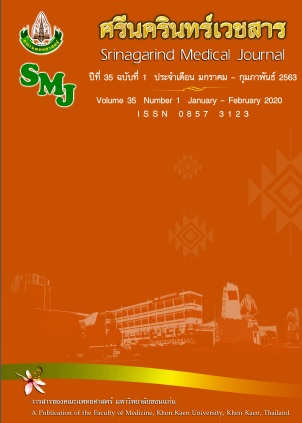The Appropriateness of Post-Exposure Management in Patients at Risk to Rabies in Emergency Room, Srinagarind Hospital
Keywords:
The post-exposure prophylaxis, Rabies, Appropriateness, Practice guideline, การให้วัคซีนป้องกันหลังสัมผัส, โรคพิษสุนัขบ้า, ความเหมาะสม แนวเวชปฏิบัติAbstract
ความเหมาะสมของการจัดการผู้ป่วยเสี่ยงสัมผัสโรคพิษสุนัขบ้าที่ห้องฉุกเฉินโรงพยาบาลศรีนครินทร์
ฐปนวงศ์ มิตรสูงเนิน1*, ธวัชชัย แซ่เตีย1, ดนุ เกษรสิริ2
1ภาควิชาเวชศาสตร์ฉุกเฉิน คณะแพทยศาสตร์ มหาวิทยาลัยขอนแก่น
2ภาควิชาเภสัชวิทยา คณะแพทยศาสตร์ มหาวิทยาลัยขอนแก่น
หลักการและวัตถุประสงค์: โรคพิษสุนัขบ้าเป็นโรคติดต่อจากสัตว์ที่มีอัตราตายสูง การจัดการผู้ป่วยที่มีความเสี่ยงชนิดหลังสัมผัสมีความสำคัญต่อการระบาดในมนุษย์ ผู้วิจัยจึงได้ทำการศึกษาความชุกของผู้ป่วยที่ได้รับการจัดการอย่างเหมาะสมตามแนวทางเวชปฏิบัติของกรมควบคุมโรค กระทรวงสาธารณสุข พ.ศ. 2556 ของไทย
วิธีการศึกษา: เป็นการศึกษาพรรณนาชนิดย้อนหลัง โดยค้นเวชระเบียนตาม International Classification of Diseases and Related Health Problem 10th revision (ICD-10) คือ T14.1, W50-W55, Z24.2 ของผู้ป่วยที่เข้ารับการรักษาในโรงพยาบาลศรีนครินทร์ในช่วงเดือนมกราคมถึงธันวาคม พ.ศ. 2557 ที่ได้รับการวินิจฉัยว่ามีประวัติเสี่ยงสัมผัสโรคพิษสุนัขบ้า
ผลการศึกษา: เมื่อค้นเวชระเบียนตาม ICD-10 พบผู้ป่วย 2,009 ราย แต่มีผู้ป่วยที่ตรงตามเกณฑ์ 960 ราย โดยมากเป็นเพศหญิง536 ราย (ร้อยละ 55.8) อายุเฉลี่ย 35.8 ปี ระยะเวลาตั้งแต่เสี่ยงสัมผัสโรคจนมาถึงโรงพยาบาลเฉลี่ย 13.4 ชั่วโมง สัตว์เสี่ยงนำโรคที่พบบ่อยที่สุดคือสุนัข (ร้อยละ 66.0) โดยส่วนใหญ่มีลักษณะการสัมผัสคือการถูกกัด บริเวณขาหรือมือ เป็นแผลระดับที่ 3 ตามเกณฑ์องค์การอนามัยโลกมีจำนวน 461 ราย (ร้อยละ 48.0) โดยมีกลุ่มที่ข้อมูลเพียงพอในการประเมินความเหมาะสม 806 ราย ซึ่งจัดการได้อย่างเหมาะสมในภาพรวมร้อยละ 48.3 ฉีดวัคซีนพิษป้องกันพิษสุนัขบ้าได้เหมาะสมร้อยละ 95.2 ฉีดอิมมูโนโกลบูลินป้องกันพิษสุนัขบ้าได้เหมาะสมร้อยละ 91.1
สรุป: การจัดการภายหลังเสี่ยงสัมผัสโรคพิษสุนัขบ้ามีความเหมาะสมตามแนวทางเวชปฏิบัติฯร้อยละ 48.3 แพทย์ฉุกเฉินจำเป็นต้องติดตามความรู้การจัดการภายหลังเสี่ยงสัมผัสโรคพิษสุนัขบ้าให้ทันสมัยและพัฒนาการลงข้อมูลในเวชระเบียนให้ครบถ้วนเพื่อความปลอดภัยของผู้ป่วย
Background and Objective: Rabies is zoonosis with high mortality rates. The post-exposure management of patients at risk impact to spreading in human. So we aimed to study the prevalence of appropriateness in post-exposure management of patients at risk to rabies by using 2013 Rabies practice guideline of Department of Disease Control, Ministry of Public Health, Thailand.
Material and Methods: A retrospective descriptive study enrolled patients who visited Srinagarind hospital between January to December 2014 by using International Classification of Diseases and Related Health Problem 10th revision (ICD-10) code T14.1, W50-W55, Z24.2.
Results: After searching by ICD-10 codes, 2009 patients were enrolled and only 960 cases met our criteria. Five hundred thirty six cases (55.8%) were women. The average age was 35.8 years old and average duration from exposure to medical contact was 13.4 hours. The most common carriers were dog (66.0%) and the characteristics of exposure were biting at leg or hand and 461 wounds (48.0%) were level III that classified by World Health Organization (WHO) category. But there were only 806 cases that contained enough data in medical record to decide appropriateness in post-exposure management. Finally, we found the overall appropriate management was 48.3%, appropriate rabies vaccine was 95.2%, and appropriate rabies immunoglobulin was 91.1%.
Conclusion: The post-exposure management of patients at risk to rabies by 2013 Rabies practice guideline was proper at 48.3%. Emergency physicians need to update the post-exposure management of patient at risk to rabies and complete the important data in medical record for patient safety
References
World Health Organization. Rabies [Internet]. WHO. [cited Feb 28, 2013]. Available from:http://goo.gl/gh4h7s.
World Health Organization. Rabies vaccines: WHO position paper [Internet]. WHO. [cited Dec 24, 2015]. Available from http://www.who.int/wer/2010/wer8532.pdf?ua=1.
Centers for Disease Control and Prevention. Use of a reduced (4-dose) vaccine schedule for postexposure prophylaxis to prevent human rabies-recommendations of the Advisory Committee on Immunization Practice. Ann Emerg Med 2010;56:64–7.
Puanghat A, Hunsoowan W. [Rabies situation in Thailand]. J Med Assoc Thai 2005; 88: 1319–22.
พันธนีย์ ธิติชัย. โรคพิษสุนัขบ้า. สรุปรายงานการเฝ้าระวังโรคประจําปี 2555 [อินเทอร์เน็ท]. 2555. [อ้างเมื่อ 17 พฤศจิกายน 2558]. จาก: http://goo.gl/U8t8IM.
นิวัช เทพสง. ลักษณะทางระบาดวิทยาของผู้ที่ถูกสงสัยว่าสัมผัสเชื้อโรคพิษสุนัขบ้าในอําเภอป่าพะยอม จังหวัดพัทลุง. 20 ธันวาคม 2558 [อินเทอร์เน็ต] 2550. [อ้างเมื่อ 17 พฤศจิกายน 2558]. จาก http://archive.lib.cmu.ac.th/full/T/2551/ mph0951nte_tpg.pdf.
Moran GJ, Talan DA, Mower W, Newdow M, Ong S, Nakase JY, et al. Appropriateness of rabies postexposure prophylaxis treatment for animal exposures. Emergency ID Net Study Group. JAMA 2000; 284: 1001–7.
Si H, Guo ZM, Hao YT, Liu YG, Zhang DM, Rao SQ, et al. Rabies trend in China (1990-2007) and post-exposure prophylaxis in the Guangdong province. BMC Infect Dis 2008; 8: 113.
Yuwares Sittichanbuncha, Chalermpon Chairat, Kittisak Sawanyawisuth. Rabies postexposure vaccination in Thailand: is it performed according to international guidelines? Asian Biomed 2014; 8: 393-7.
สำนักโรคติดต่อทั่วไป กรมควบคุมโรค. แนวทางเวชปฎิบัติโรคพิษสุนัขบ้าและคำถามที่พบบ่อย. พิมพ์ครั้งที่ 2. นนทบุรี: กลุ่มโรคติดต่อระหว่างสัตว์และคน สำนักโรคติดต่อทั่วไป; 2556.
Baddour LM, Sexton DJ, Baron EL. Soft tissue infections due to dog and cat bites [Internet]. [cited Nov 17, 2016]. Available from: http://goo.gl/lJ5IYP.
Augmentin (Amoxicillin / Clavulanate Potassium) - Description and Clinical Pharmacology [Internet]. 2006-2016. [cited Dec 24, 2015]. Available from http://www.druglib.com/druginfo/augmentin/description_pharmacology/.
Poorolajal J, Babaee I, Yoosefi R, Farnoosh F. Animal Bite and Deficiencies in Rabies Post-Exposure Prophylaxis in Tehran, Iran. Arch Iran Med 2015; 18: 822–6.


